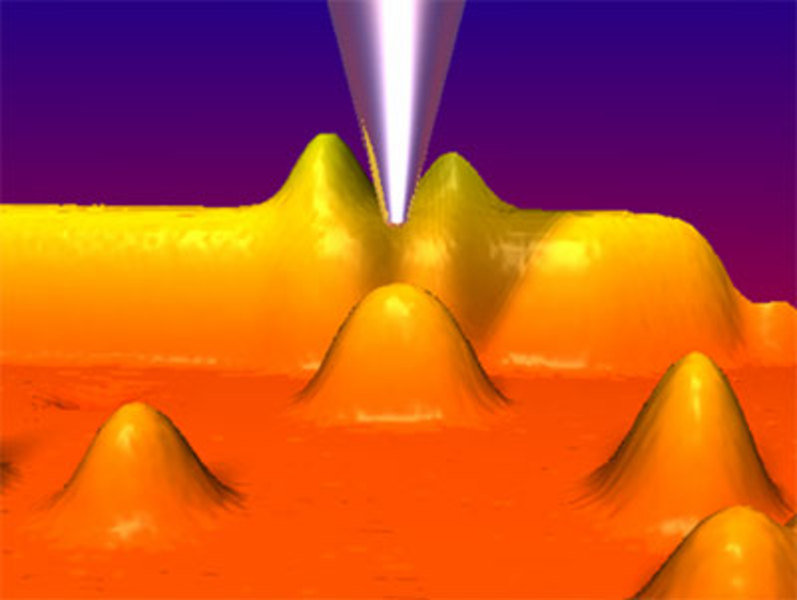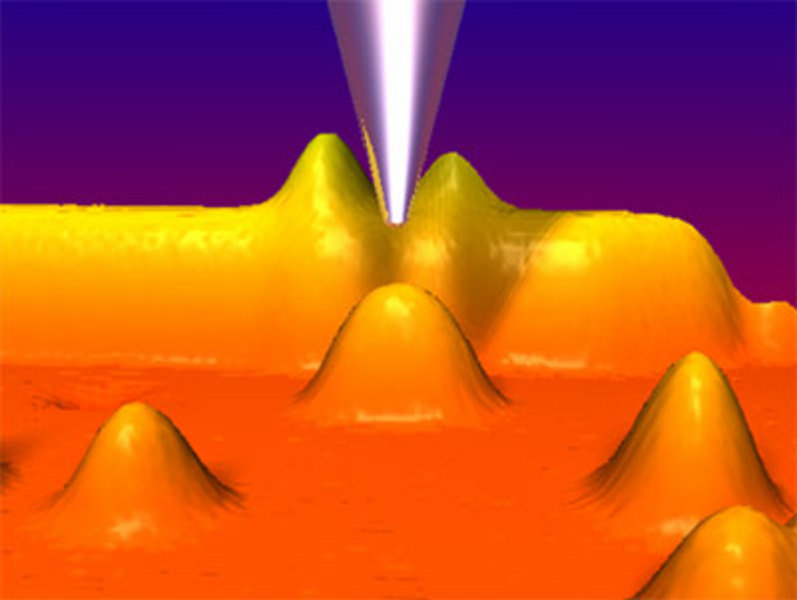Delicate Relation between Single Spins
Scientists measure the magnetic interaction between single atoms
Probing the magnetic interaction between single atoms is no longer a dream. Using a scanning tunnelling microscope, the interaction of the spins of two neighbouring cobalt atoms adsorbed at a copper surface has been measured as a function of their distance with atomic precision. This development opens up new possibilities to probe the quantum nature of magnetic phenomena and to explore the physical limits of magnetic data storage.

It is a vision of information technology to store data in the smallest available units - single atoms - thus enabling the development of novel mass storage devices with huge capacities but compact dimensions. It is crucial to understand the mutual interaction and dynamics of individual spins, both for realising such a visionary device as well as to explore the limits of conventional mass storage media. New insights into these interactions can find direct application in the advancement of magnetic recording techniques as well as in the development of novel spin-based information technologies such as quantum computers. Max-Planck researchers from Stuttgart and Halle in collaboration with colleagues from the CNRS in Grenoble have succeeded in accessing the interaction between single magnetic adatoms on a metal surface by comparing experimental results obtained with a scanning tunnelling microscope with a detailed theoretical analysis. The interaction between single magnetic adatoms has been theoretically analyzed already in the middle of last century and the predictions could now for the first time be compared with experiments on single atoms.
The metallic tip of a scanning tunnelling microscope passes over a conducting surface thereby giving access to an atomic scale height map. In order to measure the tiny magnetic effects, the researchers had to cool their microscope to low temperatures (-267°C or -448.6°F) and conduct the experiments in a vibration-isolated and sound-proof environment. The low temperature on the one hand freeze the motion of the atoms which enables the investigation of single atoms in the first place, on the other hand the spectroscopic resolution of the experiment is increased. The atomic arrangements in which the interactions have been studied were prepared by selectively dissociating single molecules containing cobalt atoms with the tip of the scanning tunnelling microscope.
As a probe for the magnetic interactions the researchers have exploited an electronic many body effect, the Kondo effect. This effect is due to the interaction of the spin of a magnetic adatom with the electrons of the metallic substrate. The effect can (at low temperatures) be detected by the scanning tunnelling microscope as resonance in the local electronic density of states. By a detailed analysis of the dependence of the Kondo resonance on the distance between two adjacent cobalt adatoms on a copper surface, the researchers were able to probe their magnetic interactions. This enabled for the first time a direct comparison of theoretical calculations for the magnetic interaction between single atoms on a metal surface with experimental data.
The researchers also observed a novel magnetic state for a chain of three cobalt adatoms, which is a correlated state of the spins of the three constituting atoms.
The results of the Max-Planck researchers are promising first steps toward developing new pathways for manipulating and engineering materials and nanostructures on the atomic scale by exploiting the quantum nature of magnetism. At the same time the results improve our understanding of the fundamental interactions between single spins.
